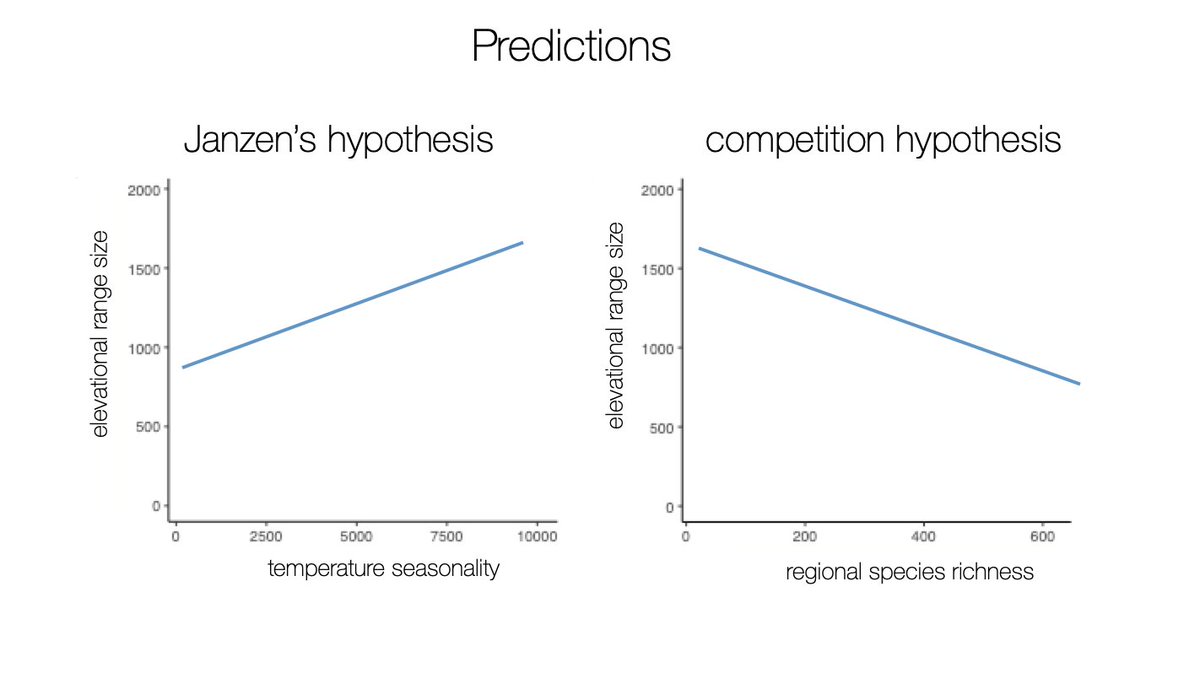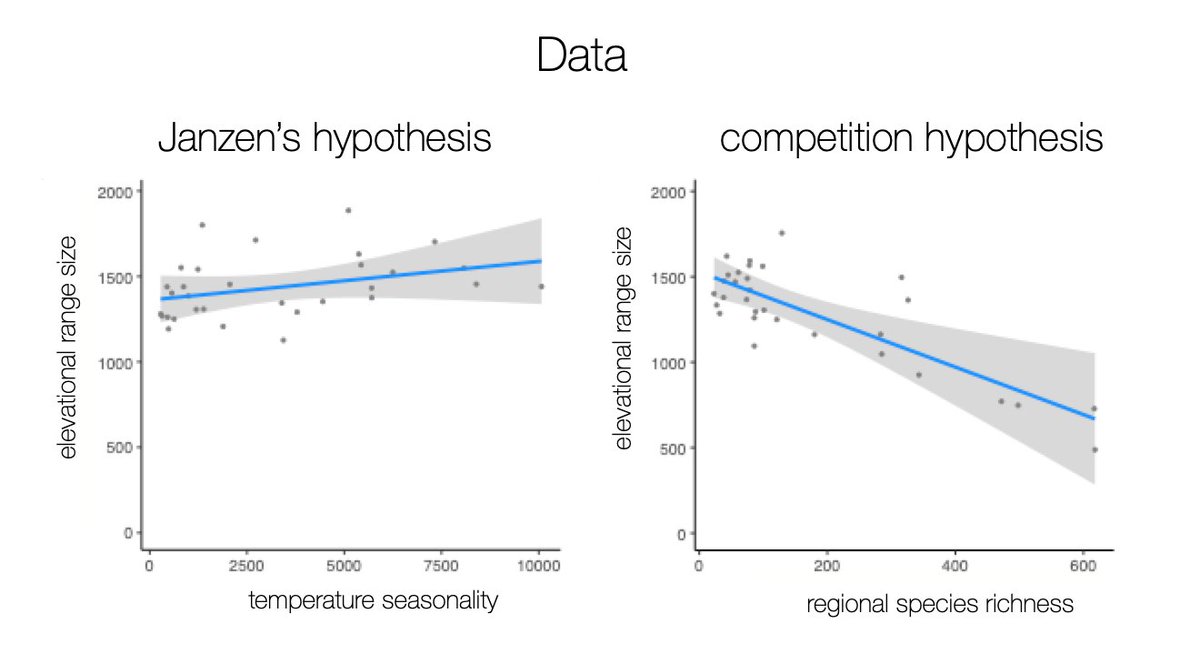We analyzed 4.4 million @Team_eBird records to find out why tropical birds live in narrow slices of mountainside
You won’t BELIEVE what we found
Out today in #ScienceResearch
science.org/doi/10.1126/sc…
w/ @StrimasMackey & @EliotITMiller
You won’t BELIEVE what we found
Out today in #ScienceResearch
science.org/doi/10.1126/sc…
w/ @StrimasMackey & @EliotITMiller

But first the backstory.
As you travel up or down a tropical mountain, you will find very different species in each elevational zone. Way more so than on temperate zone mountains. This species turnover explains why tropical mountains are Earth’s hottest biodiversity hotspots
As you travel up or down a tropical mountain, you will find very different species in each elevational zone. Way more so than on temperate zone mountains. This species turnover explains why tropical mountains are Earth’s hottest biodiversity hotspots

We began studying this puzzle 15 yrs ago in tropical Andes
Want to find different tanagers, antpittas, or hummingbirds? Move 500 m up or downslope. Exciting! And puzzling! Forests often look similar and birds have wings. Why don’t they live in broader elevational ranges?

Want to find different tanagers, antpittas, or hummingbirds? Move 500 m up or downslope. Exciting! And puzzling! Forests often look similar and birds have wings. Why don’t they live in broader elevational ranges?


So why do tropical birds live in narrow slices of mountainside?
People usually point to climate. It’s hot in the lowlands and cool in the mountains. Maybe birds live only within the elevations that are just right for them - their Goldilocks zone
People usually point to climate. It’s hot in the lowlands and cool in the mountains. Maybe birds live only within the elevations that are just right for them - their Goldilocks zone

Dan Janzen described how this might come to be in his famous “Why mountain passes are taller in the tropics” article
The low temp seasonality of tropical mountains means species only experience a narrow range of temps & might evolve specialized thermal physiology to these temps

The low temp seasonality of tropical mountains means species only experience a narrow range of temps & might evolve specialized thermal physiology to these temps


This idea has climate change repercussions - if tropical species are thermal specialists, warming should lead to physiological stress & set in motion an “escalator to extinction” for tropical sp. And this is what we see!
onlinelibrary.wiley.com/doi/abs/10.111…
onlinelibrary.wiley.com/doi/abs/10.111…
But at the same time that Janzen put forth his pioneering ideas, others were emphasizing how species interactions can also constrain elevational ranges
For example, researchers documented cases where species inhabited narrow ranges on mountains with lots of species but broader ranges on mountains with fewer species (& esp when close relatives were absent), and argued that interspecific competition explained these patterns 

In the decades that followed, researchers found:
- evidence that temperature seasonality matters, and
- evidence that competition matters
tons of papers including e.g.,
pnas.org/doi/abs/10.107…
royalsocietypublishing.org/doi/full/10.10…
academic.oup.com/auk/article/13…
- evidence that temperature seasonality matters, and
- evidence that competition matters
tons of papers including e.g.,
pnas.org/doi/abs/10.107…
royalsocietypublishing.org/doi/full/10.10…
academic.oup.com/auk/article/13…
We wanted to measure the relative importance of these two hypotheses.
We took a comparative approach & analyzed forest species’ elevational ranges in regions that differ in their temperature seasonality (Janzen hypothesis) and regional species richness (competition hypothesis)
We took a comparative approach & analyzed forest species’ elevational ranges in regions that differ in their temperature seasonality (Janzen hypothesis) and regional species richness (competition hypothesis)

Problem: Defining forest species’ elevational ranges within regions is hard
Solution: use @ebird data (the 4.4 million records bit)
We came up with a frequency-based method to define ranges using eBird checklists that met stringent filtering criteria
Solution: use @ebird data (the 4.4 million records bit)
We came up with a frequency-based method to define ranges using eBird checklists that met stringent filtering criteria

We then asked whether mean elevational range size within regions was better predicted by temperature seasonality (Janzen hypothesis) or by regional species richness (competition hypothesis) 

And found....
that regional species richness is a strong predictor of mean elevational range size, consistent with competition hypothesis
Regional species richness also correlated with variation in elevational range sizes for species that live in multiple regions
that regional species richness is a strong predictor of mean elevational range size, consistent with competition hypothesis
Regional species richness also correlated with variation in elevational range sizes for species that live in multiple regions

To illustrate these patterns, we compare W (Choco) & E (Amazon) slopes of tropical Andes at the equator
Similar temp seasonality & mountain height
Tons of species in both, but even more on Amazon slope
And, correspondingly, narrower elevational ranges on the Amazon slope
Similar temp seasonality & mountain height
Tons of species in both, but even more on Amazon slope
And, correspondingly, narrower elevational ranges on the Amazon slope

So how might more species lead to narrow elevational ranges?
There are many possible mechanisms. To begin to shed some light, we looked at pairwise competition between elevational replacements, the mechanism originally highlighted as pointing to a role for competition
There are many possible mechanisms. To begin to shed some light, we looked at pairwise competition between elevational replacements, the mechanism originally highlighted as pointing to a role for competition

We asked whether species exhibit competitive release in allopatry for 52 natural experiments in Neotropics, using eBird data to define competitive release in elevational & environmental space
We used this comparative approach to avoid cherry-picking particular cases
We used this comparative approach to avoid cherry-picking particular cases

And…we find competitive release around half the time
We find evidence that pairwise competition limits the elevational ranges of species like Black-faced Anthrush Formicarius analis (photo credit: Luiz Matos, ML68863331)
We find evidence that pairwise competition limits the elevational ranges of species like Black-faced Anthrush Formicarius analis (photo credit: Luiz Matos, ML68863331)

and for Phaethornis hermits, Campephilus woodpeckers, Spizaetus hawk-eagles and many more
credits: Peter Hawrylyshyn ML69744221, Fernando Burgalin Sequeria ML179056551, Nailson Júnior ML367075101, Pablo Ortega ML443711351



credits: Peter Hawrylyshyn ML69744221, Fernando Burgalin Sequeria ML179056551, Nailson Júnior ML367075101, Pablo Ortega ML443711351




So we find many examples of competitive release, suggesting competitive exclusion in sympatry. But also plenty of examples of natural experiments where we find no evidence for competition 

What gives?
Can we explain why we see competitive release sometimes but not others?
Yes, we can - we find that behavior matters (but relative elevational position does not - i.e. competition not more important at warm limit)
Can we explain why we see competitive release sometimes but not others?
Yes, we can - we find that behavior matters (but relative elevational position does not - i.e. competition not more important at warm limit)

To sum up: We use eBird data to report evidence that interspecific competition is a major reason why tropical birds live in narrow slices of mountainside
This suggests a new interpretation for why tropical montane birds (and maybe other tropical taxa) are shifting dramatically upslope - warming likely causes these upslope shifts indirectly, by altering outcomes of species interactions, rather than directly via physiological stress
Massive thanks to everyone who submits their observations of montane birds to @Team_eBird using fine-scale location data (e.g. point counts, 1 km traveling counts)
ok everyone log off & go eBirding in mountains!
(& join the Mountain Bird Network)
benjamingfreeman.com/mountainbirdne…
ok everyone log off & go eBirding in mountains!
(& join the Mountain Bird Network)
benjamingfreeman.com/mountainbirdne…
• • •
Missing some Tweet in this thread? You can try to
force a refresh







